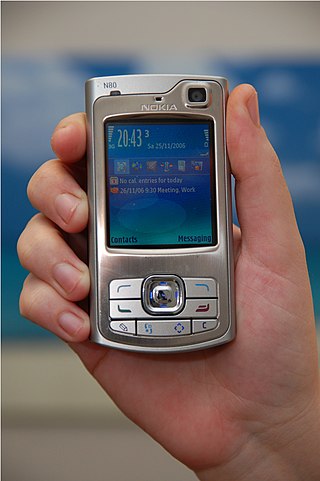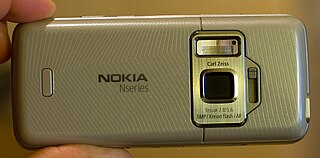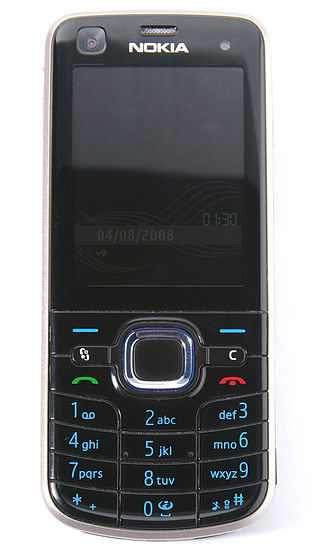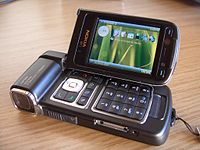
The Nokia 6680 is a high-end 3G mobile phone running Symbian operating system, with Series 60 2nd Edition user interface. It was announced on 14 February 2005, and was released the next month. The 6680 was Nokia's first device with a front camera, and was specifically marketed for video calling. It was also Nokia's first with a camera flash. It was the forerunner of the Nseries, which was released in April 2005; its successor being the N70.

The Nokia N90 is a mobile phone, announced as part of Nokia's then-new line of multimedia devices, Nseries, on April 27, 2005. It had a unique swivel design encompassing four 'modes'. It has two displays and has a camera with Carl Zeiss optics and integrated flash, and can record video with audio. The screen can be swiveled 270° to mimic the appearance of a camcorder. The camera lens can also be swiveled. The 2.1-inch display has a pixel density of 259 ppi, considered the most crispest Nokia screen at the time, and continued to be joint-highest with the N80, E60 and E70 for four years, before being beaten by the Nokia N900 in 2009 with 267 ppi. The Nokia N90 can print with some printers over USB or over Bluetooth.

The Nokia N70 is a 3G mobile phone from Nokia. It was announced as part of the Nokia's new line of multimedia smartphones, the Nseries, on 27 April 2005. It started shipping in September 2005. It runs on the S60 2nd Edition, Feature Pack 3 on Symbian v8.1 operating system. It was succeeded by the Nokia N73. The N70 was popular and sold well.

The Nokia N92 is a mobile phone part of the multimedia Nseries. It was announced on November 2, 2005 and was the world's first mobile phone with an integrated DVB-H tuner. As a result, Nokia marketed it as a phone for watching TV on the go. It featured the same swivel design as the N90. It runs on Symbian OS v9.1 and the S60 3rd Edition interface.

The Nokia N80 is a 3G mobile phone from Nokia announced on November 2, 2005, part of the multimedia Nseries line. It runs on Symbian OS v9.1 and the S60 3rd Edition interface. It was first released in June 2006.

The Nokia N79 is a Symbian OS v9.3 mobile phone and a member of the Nokia Nseries multimedia smartphone family running on S60 3rd Edition Feature Pack 2. It was officially announced by Nokia on 26 August 2008. The N79 is an advanced device with a 5 megapixel camera, dual LED flash, and GPS, with many improvements over the Nokia N78. It retailed for 350 euros upon release in October 2008.

The Nokia N95 is a mobile phone produced by Nokia as part of their Nseries line of portable devices. Announced in September 2006, it was released to the market in March 2007. The N95 ran S60 3rd Edition, on Symbian OS v9.2. It has a two-way sliding mechanism, which can be used to access either media playback buttons or a numeric keypad. It was first released in silver and later on in black, with limited edition quantities in gold and purple. The launch price of the N95 was around €550.

The Nokia N93i is a mobile phone produced by Nokia, announced on 8 January 2007 and released the same month. It is part of the Nseries line and is a redesign of the Nokia N93. The N93i runs on Symbian OS version 9.1, with the S60 3rd Edition user interface. Like the N93, it is a clamshell and swivel design with a camera and landscape position.
The Nokia 6000 series or Classic Business series is range of mobile phones marketed by Nokia. This family of phones is notable for their conservative, unisex designs, making them popular with business users.

The Nokia N82 is a high-end mobile phone produced by Nokia, and announced on 14 November 2007 as part of the company's Nseries line. The N82 runs Symbian OS v9.2. The N82 inherits much of the Nokia N95's features and specifications, with the major addition being its xenon flash. At the time the N82 was considered one of the most sophisticated camera phone on the market. It is also considered a successor to the Nokia N95, preceding the Nokia N96.

Nokia 6220 classic is a Symbian OS mobile phone announced by Nokia on 11 February 2008. It is notable for featuring a Xenon flash for its 5-megapixel camera, similar to Nokia N82 and often considered as a "budget" version of the N82. Despite its compact size, it offers features comparable to the Nseries lineup, though it lacks Wi-Fi and a 3.5 mm audio jack, probably to cut design and production costs.

The Nokia N86 8MP is a high-end mobile phone with emphasis on the camera. It was announced on 17 February 2009 and released in May 2009 as part of the Nseries. It runs on Symbian OS 9.3 and shares similar design features with the N97. Its name references the camera's megapixel count.

The Nokia 6720 is a mid-range Symbian OS mobile phone released by Nokia. It was unveiled to public in Barcelona and Singapore on February 16, 2009. It is the successor of the Nokia 6220 classic and features several improvement over its predecessor, such as the addition of A-GPS and noise cancellation. Like the 6220, it offers features comparable to the higher end models, although the Xenon flash previously featured in the 6220 is now replaced by a conventional LED flash for higher power efficiency.

The Nokia 6710 Navigator is a mobile phone made by Nokia, announced on 16 February 2009. that is a successor to Nokia 6210 Navigator. It was released in August 2009. The Nokia 6710 Navigator is the fourth device in the Navigator series to be released by Nokia. The Nokia 6710 Navigator includes pre-loaded navigation maps with a lifetime free navigation license.

The Nokia N8 is a touchscreen-based smartphone developed by Nokia. Announced on 27 April 2010, the Nokia N8 was the first device to run on the Symbian^3 mobile operating system and it was the company's flagship device for the year. It was released on 30 September 2010 at the Nokia Online Store before being released in markets around the world on 1 October 2010. There were two version made, the N8 and the N8-00. The N8 was made for Vodafone and locked to its networks, and the N8-00 was made by Microsoft and open network.
The Nokia C6-01 is a Symbian^3 smartphone from the Nokia Cseries. The C6-01 display features comes with a 3.2in AMOLED display with capacitive touchscreen capabilities and Nokia's ClearBlack technology for improved outdoor visibility. The smartphone was released on November 4, 2010 for €260, excluding taxes and subsidies.

The Nokia C7-00 is a smartphone from the Nokia Cseries. It was introduced on 14 September 2010 and released in Q4 2010. The C7-00 features a 3.5-inch (89 mm), 640 x 360 pixel capacitive touchscreen and features 720p video recording, and was also the world's first smartphone to have NFC capability. Nokia's mobile phone business head Anssi Vanjoki called it the "sleekest" device in the world. Unlike the Nokia N8 flagship, the C7 has physical call and hangup buttons.

The Nokia Nseries was a high-end lineup of feature phones, smartphones, and tablets marketed by Nokia Corporation from 2005 to 2011. The Nseries devices commonly supported multiple high-speed wireless technologies at the time, such as 3G, or Wireless LAN. Digital multimedia services, such as music playback, photo/video capture or viewing, gaming or internet services were the central focus of the lineup. The lineup was replaced in 2011 by the Nokia Lumia line as the company's primary smartphone lineup.
Nokia's strategic nomenclature can be traced back in 2005 when the Nseries line was launched, offering devices with flagship specifications and premium hardware at various price points. These devices were considered the "bread and butter" of the company and were often positioned to showcase their latest technologies. Thanks to the newfound consumer and enterprise interest in smartphones at the time, the company introduced four additional collections to diversify their product portfolio and meet demands in most market segments. These new phone series were named Eseries, targeting small business and enterprise customers; Xseries, providing consumer-grade multimedia-focused devices; Cseries, which Nokia used to target both the low-end and mid-range market segments; and Tseries, for devices exclusive to the Chinese market.

The Nokia 603 is a Symbian smartphone announced on 13 October 2011. It ships with the Symbian Belle OS. Later with the release of Nokia 808 PureView, an update of Belle Feature Pack 2 was released for the phone. Nokia 603 is a low-cost device featuring a 3.5-inch ClearBlack display, 1.0 GHz processor, and NFC.

















